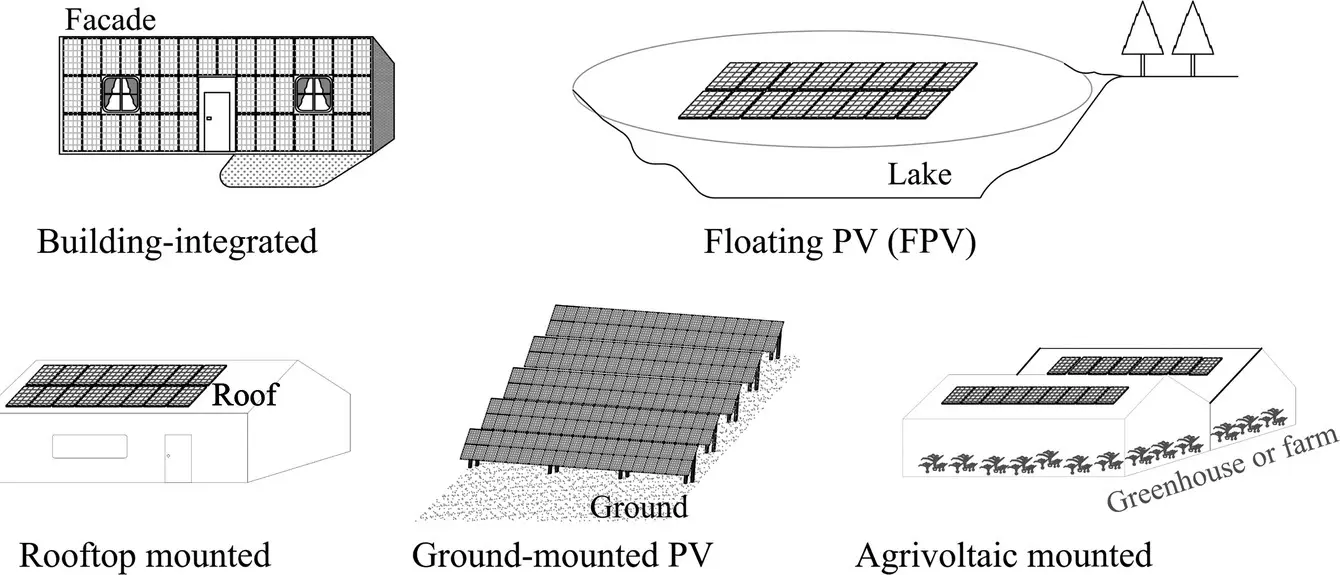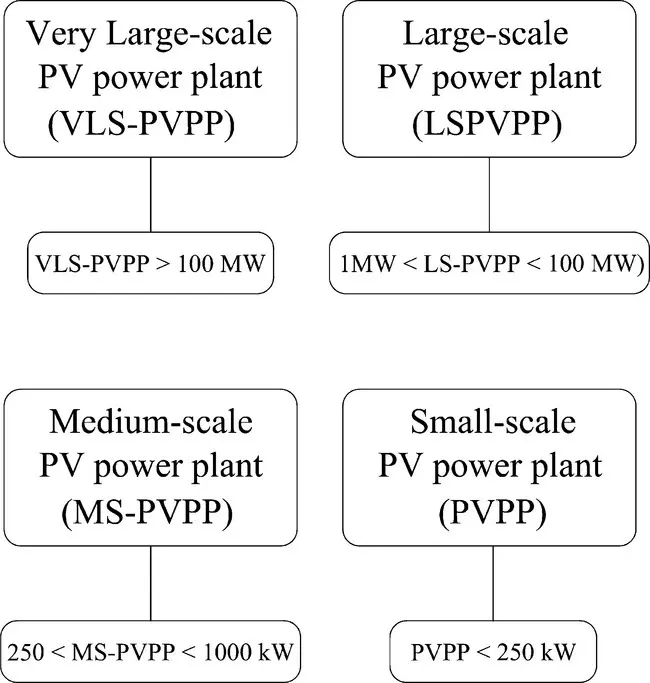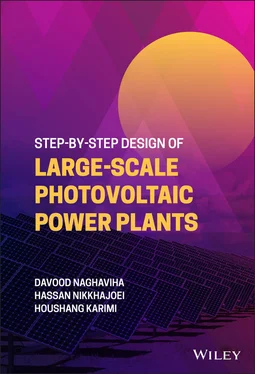Houshang Karimi - Step-by-Step Design of Large-Scale Photovoltaic Power Plants
Здесь есть возможность читать онлайн «Houshang Karimi - Step-by-Step Design of Large-Scale Photovoltaic Power Plants» — ознакомительный отрывок электронной книги совершенно бесплатно, а после прочтения отрывка купить полную версию. В некоторых случаях можно слушать аудио, скачать через торрент в формате fb2 и присутствует краткое содержание. Жанр: unrecognised, на английском языке. Описание произведения, (предисловие) а так же отзывы посетителей доступны на портале библиотеки ЛибКат.
- Название:Step-by-Step Design of Large-Scale Photovoltaic Power Plants
- Автор:
- Жанр:
- Год:неизвестен
- ISBN:нет данных
- Рейтинг книги:3 / 5. Голосов: 1
-
Избранное:Добавить в избранное
- Отзывы:
-
Ваша оценка:
- 60
- 1
- 2
- 3
- 4
- 5
Step-by-Step Design of Large-Scale Photovoltaic Power Plants: краткое содержание, описание и аннотация
Предлагаем к чтению аннотацию, описание, краткое содержание или предисловие (зависит от того, что написал сам автор книги «Step-by-Step Design of Large-Scale Photovoltaic Power Plants»). Если вы не нашли необходимую информацию о книге — напишите в комментариях, мы постараемся отыскать её.
Step-by-Step Design of Large-Scale Photovoltaic Power Plants,
Step-by-Step Design of Large-Scale Photovoltaic Power Plants
Step-by-Step Design of Large-Scale Photovoltaic Power Plants
Step-by-Step Design of Large-Scale Photovoltaic Power Plants — читать онлайн ознакомительный отрывок
Ниже представлен текст книги, разбитый по страницам. Система сохранения места последней прочитанной страницы, позволяет с удобством читать онлайн бесплатно книгу «Step-by-Step Design of Large-Scale Photovoltaic Power Plants», без необходимости каждый раз заново искать на чём Вы остановились. Поставьте закладку, и сможете в любой момент перейти на страницу, на которой закончили чтение.
Интервал:
Закладка:

Figure 1.9 Different types of PV plants based on their installation location.
Source : Goodrich et al. [6]. Public Domain.

Figure 1.10 Classification of power plants in terms of their mounted places.
The commercial, industrial, and utility‐scale PV plants are classified into five categories as shown in Figure 1.10, namely, ground‐mounted, floating, building‐integrated, rooftop mounted, and agrivoltaics. A ground‐mounted PV plant is installed on a land, whereas a floating PV plant is installed on a water lake. In a building‐integrated PV plant, solar panels are placed in the facade of a building. An agrivoltaics or agrophotovoltaics plant is installed in a greenhouse or agricultural farm and a rooftop mounted PV plant is installed on roof of a house, building, or factory [7].

Figure 1.11 Classification of power plants in terms of size.
Source : Rakhshani et al. [8]. Licensed Under CC BY 4.0.
Figure 1.11shows that the PV power plants can be categorized into four groups based on their output power: small‐scale, medium‐size, large‐scale, and very LS‐PVPPs [8]. The large‐scale PV plants are known as solar farms and the very large‐scale PV plants are commonly known as solar parks. In addition to a distribution substation, the large‐scale and very‐large‐scale PV plants usually have one or more transmission or sub‐transmission substations.
1.3 Global PV Power Plants
In the last two decades, significant numbers of PV power plants have been installed worldwide. The cumulative installed capacity of PV plants by the end of 2020 has reached about 751 GW. There are few reasons for investing in solar plants. The most important ones are:
1 The economic incentives that some countries grant the investors by providing subsidies or purchasing PV power at high rates. Such incentives are included in the guaranteed electricity purchase tariff and are defined as a refund for the installed PV plants.
2 The improvement in the efficiency of PV modules in recent years. Figure 1.12shows the curves of the efficiency improvement of PV modules for monocrystals and polycrystals from 2010 to 2020 [9].
3 The reduction in the costs of inverters and PV modules in recent years. The number of manufacturers of inverters and PV modules has significantly increased over the past few years. Due to the competitive market, the price of solar inverters and PV modules has been declining to date. Reducing the costs of equipment has led to generating more economical energy from PV plants. Figures 1.13and 1.14show the cost trends of solar inverters and PV modules from 2010 to 2020, respectively [9]. Figure 1.12 Average module efficiency, 2010–2020.Source: Modified from Feldman et al. [9]. Figure 1.13 Utility‐scale and commercial inverter prices, 2010–2020.Source: Modified from Feldman et al. [9].
4 Producing electric power from the sun is viable in most places and it helps to reduce the earth's greenhouse gases. Following the Paris Climate Accords, adopted in December 2015, an effective way taken by most countries to reduce the greenhouse gases has been to construct more numbers of PV plants. The Paris Agreement aims to achieve a neutral climate without greenhouse gas emissions by 2050. Figure 1.14 PV modules prices, 2015–2020.Source: Modified from Feldman et al. [9].
1.4 Perspective of PV Power Plants
To predict the growth of large‐scale PV plants, the advantages and disadvantages of PV plants should be identified. A more realistic vision about the future of PV plants can be imagined by considering the fundamental crises of global energy consumption and the leading policies for its resolution. In this section, some of the advantages and disadvantages of the grid‐connected PV plants are discussed.
The most important advantages of the grid‐connected PV plants are:
Worldwide availability.
Long life of 20–30 years.
Low depreciation due to the lack of mechanical and thermal machinery.
Ability to generate on‐site consumption and save on energy transmission and distribution costs.
Low installation time (less than two years).
Low maintenance costs and ease of operation.
No production costs including the costs of fuel, marketing, and wages.
Usable in remote areas.
Generation of clean energy with no pollution.
Insignificant use of water.
Providing employment opportunities.
Independency on fossil fuels.
The most important disadvantages of the grid‐connected PV plants are:
Occupying a large land area.
No energy production at night without energy storage system.
High investment cost in addition to investment barriers.
Reduced output power at high temperatures and at the end of operation period.
Requiring a land suitable for construction and having access to the power network.
Different electricity purchase policies in different countries.
Taking time to obtain construction permits.
Some of the crises in the global energy demand and environment are:
Annual increase in energy demand.
Limited fossil fuel resources.
Increased environmental pollution from fossil fuels.
Increased CO2 emission in the atmosphere, causing global warming.
Frequent and severe storms, drought, and sea level rises.
Given the PV plants advantages and disadvantages and global energy crises, it turns out that a large numbers of PV plants are needed to achieve long‐term climate goals and to address the energy crises. Therefore, a significant growth of PV plants across the planet is expected in the near future.
The International Energy Agency (IEA) has forecast the global installed solar plants capacity by 2030 as shown in Figure 1.15. This prediction is based on considering various scenarios as described below [10].
There are uncertainties during the Covid‐19 pandemic, its economic and social impacts, and the policy responses. The stated policies assume that the Covid‐19 is gradually brought under control in 2021, and the global economy returns to pre‐pandemic levels in the same year.
The delayed recovery scenario is designed with the same policy assumptions as in the stated policies scenario, but a prolonged pandemic causes lasting damage to economic prospects. The global economy returns to its precrisis size only in 2023, and the pandemic ushers in a decade with the lowest rate of energy demand growth since the 1930s.
The sustainable development scenario assumes the energy system on track to achieve sustainable energy objectives in full, including the Paris Agreement, energy access, and air quality goals.
The new net‐zero emissions by 2050 case (NZE2050) extend the sustainable development scenario analysis. A rising number of countries and companies are targeting net‐zero emissions by midcentury. These are achieved in the sustainable development scenario, putting global emissions on track for net‐zero by 2050. The NZE2050 includes the first detailed IEA modeling of what would be needed in the next 10 years to put global CO2 emissions on track for net zero by 2050 [10]. Figure 1.15 Global solar PV and coal‐fired installed capacity by scenario, 2010–2030.Source: IEA [10].
Читать дальшеИнтервал:
Закладка:
Похожие книги на «Step-by-Step Design of Large-Scale Photovoltaic Power Plants»
Представляем Вашему вниманию похожие книги на «Step-by-Step Design of Large-Scale Photovoltaic Power Plants» списком для выбора. Мы отобрали схожую по названию и смыслу литературу в надежде предоставить читателям больше вариантов отыскать новые, интересные, ещё непрочитанные произведения.
Обсуждение, отзывы о книге «Step-by-Step Design of Large-Scale Photovoltaic Power Plants» и просто собственные мнения читателей. Оставьте ваши комментарии, напишите, что Вы думаете о произведении, его смысле или главных героях. Укажите что конкретно понравилось, а что нет, и почему Вы так считаете.












